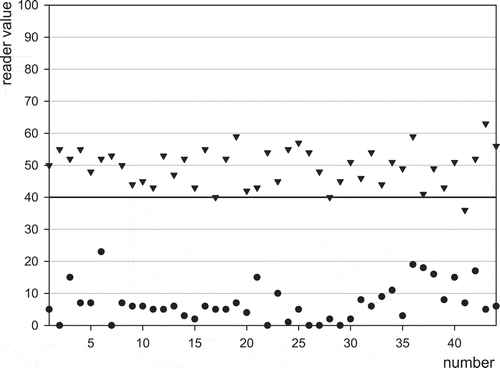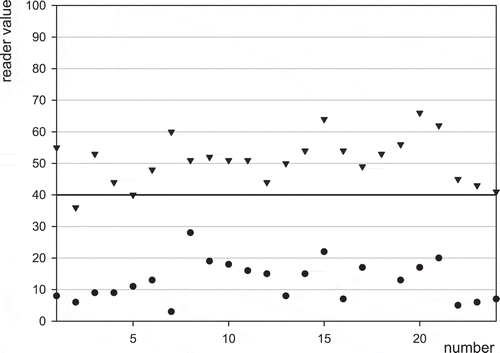Figures & data
Table 1. Spike milk sample results of MRLAFMQ by means of the ROSA Pearl Reader.
Table 2. Spike milk sample results of MRLAFMQ by means of the EZ Reader.
Table 3. Test selectivity of MRLAFMQ test for aflatoxin M1.
Table 4. Reader repeatability of MRLAFMQ.
Table 5. Test repeatability of MRLAFMQ.
Table 6. Summary of negative and positive results with different farm milk, tanker/truck milk and reconstituted milk powder samples.
Table 7. Effect of change in milk volume on MRLAFMQ readings.
Table 8. Effect of the milk temperature on MRLAFMQ readings.
Figure 1. Effect of milk composition or quality effects on the screening of blank milk using MRLAFMQ and EZ Reader. Maximum reading (▾), average reading (■), minimum reading (), control point (40 ng l−1) dividing positive from negative (▬▬); 1 = reference: normal raw cows’ milk, 2 = somatic cell count > 106 ml−1, 3 = high bacterial count (>5 × 105 ml−1), 4 = low fat content (<2 g 100 ml−1), 5 = high fat content (>6 g 100 ml−1), 6 = low protein (<3 g 100 ml−1), 7 = high protein (>4 g 100 ml−1), 8 = low pH (6.0), 9 = high pH (7.5).
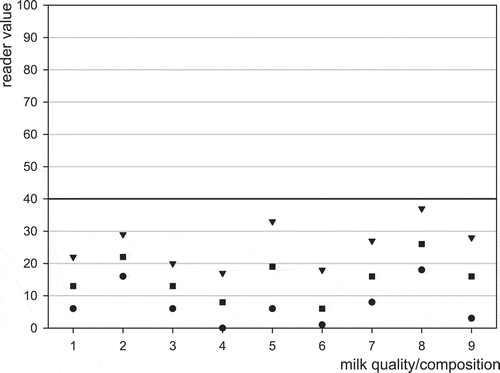
Figure 2. Effect of milk composition or quality on the detection of 50 ng l–1 aflatoxin M1 in milk using MRLAFMQ and EZ Reader. Maximum reading (▾), average reading (■), minimum reading (), control point (40 ng l−1) dividing positive from negative (▬▬); 1 = reference: normal raw cows’ milk, 2 = somatic cell count > 106 ml−1, 3 = high bacterial count (>5 × 105 ml−1), 4 = low fat content (<2 g 100 ml−1), 5 = high fat content (>6 g 100 ml−1), 6 = low protein (<3 g 100 ml−1), 7 = high protein (>4 g 100 ml−1), 8 = low pH (6.0), 9 = high pH (7.5).

Table 9. Pasteurised whole-milk spike sample results of MRLAFMQ by means of the ROSA Pearl Reader.
Table 10. Pasteurised whole-milk spike sample results of MRLAFMQ by means of the EZ Reader.
Figure 3. Screening of different blank milk types using MRLAFMQ and ROSA Pearl Reader. Maximum reading (▾), average reading (■), minimum reading (), control point dividing positive from negative (▬▬) ; 1 = reference: normal raw cows’ milk, 2 = UHT milk, 3 = sterilised milk, 4 = reconstituted powder, 5 = frozen–thawed, 6 = goats’ milk, 7 = mares’ milk.
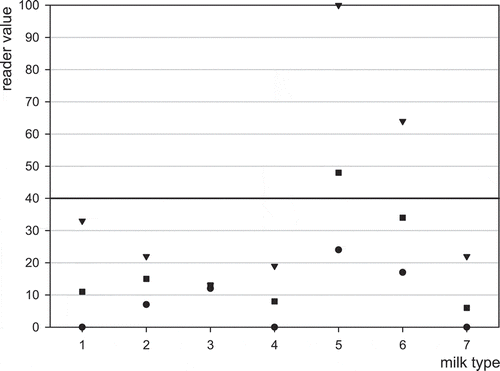
Figure 4. Detection of 50 ng l−1 aflatoxin M1 in different milk types using MRLAFMQ and ROSA Pearl Reader. Maximum reading (▾), average reading (■), minimum reading (), control point dividing positive from negative (▬▬) ; 1 = reference: normal raw cows’ milk, 2 = UHT milk, 3 = sterilised milk, 4 = reconstituted powder, 5 = frozen–thawed, 6 = goats’ milk, 7 = mares’ milk.
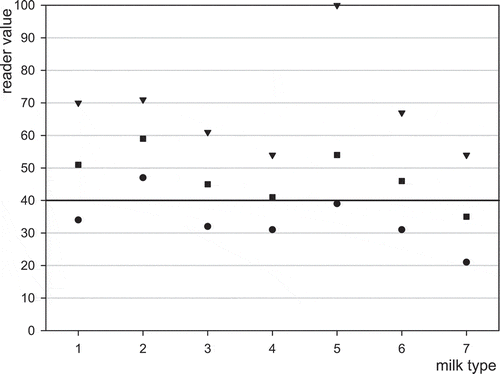
Table 11. Testing of blank milk, milk spiked with 25 ng l−1 aflatoxin M1, 50 ng l−1 aflatoxin M1 and 75 ng l−1 aflatoxin M1 using two different lots of MRLAFMQ.

